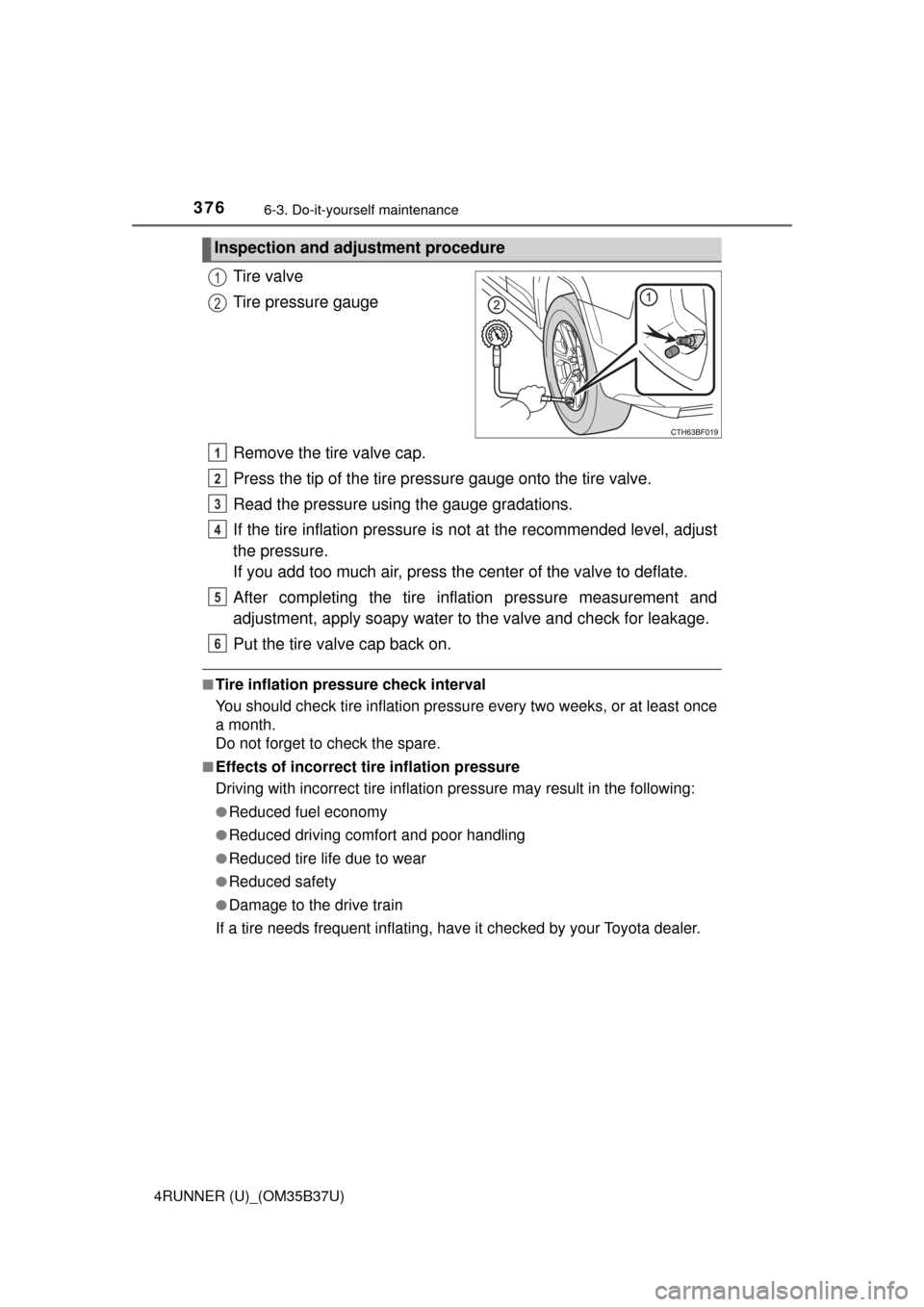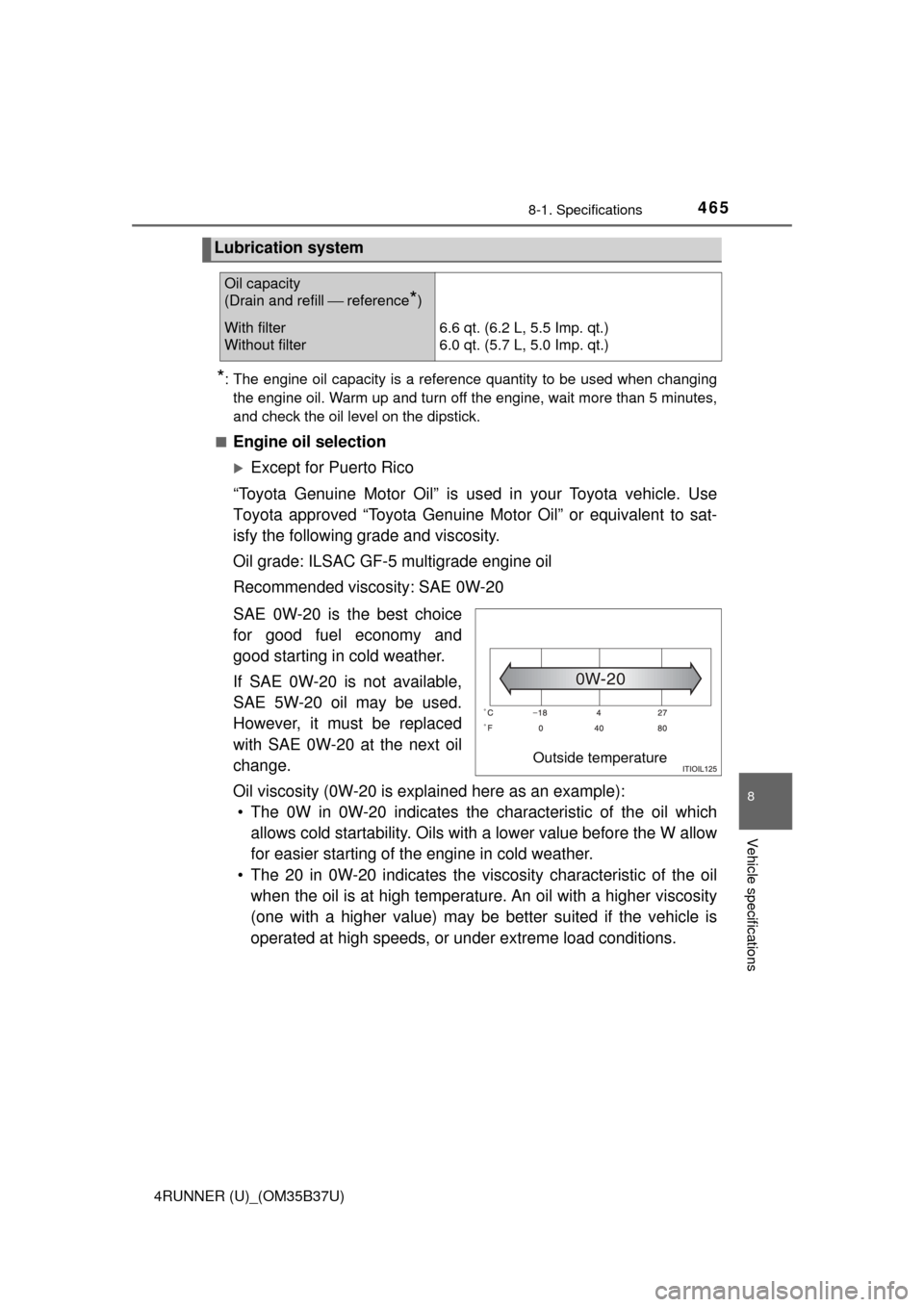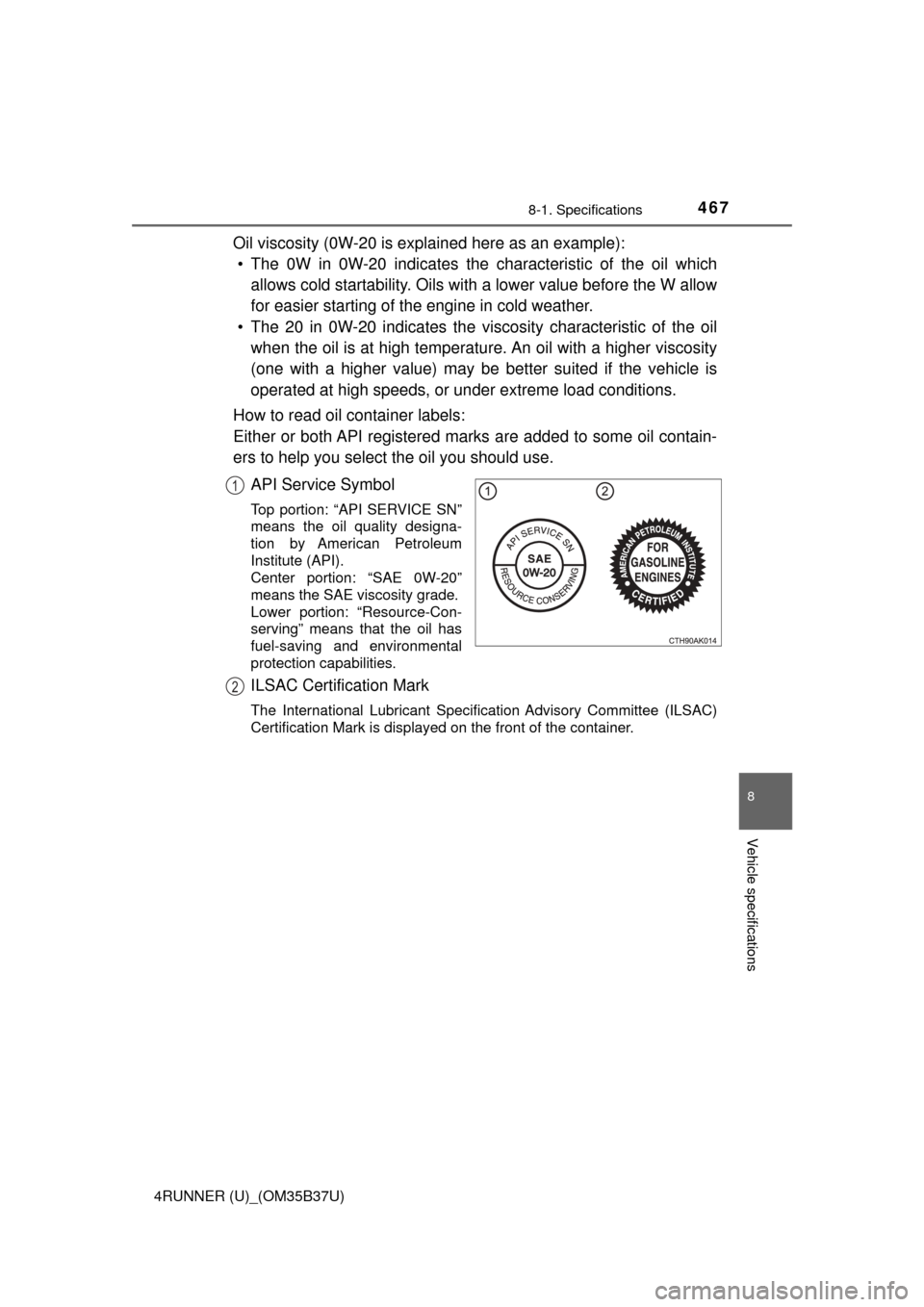2017 TOYOTA 4RUNNER fuel cap
[x] Cancel search: fuel capPage 376 of 528

3766-3. Do-it-yourself maintenance
4RUNNER (U)_(OM35B37U)
Tire valve
Tire pressure gauge
Remove the tire valve cap.
Press the tip of the tire pressure gauge onto the tire valve.
Read the pressure usi ng the gauge gradations.
If the tire inflation pressure is not at the recommended level, adjust
the pressure.
If you add too much air, press the center of the valve to deflate.
After completing the tire inflation pressure measurement and
adjustment, apply soapy water to the valve and check for leakage.
Put the tire valve cap back on.
■Tire inflation pressure check interval
You should check tire inflation pressure every two weeks, or at least once
a month.
Do not forget to check the spare.
■Effects of incorrect tire inflation pressure
Driving with incorrect tire inflation pressure may result in the following:
●Reduced fuel economy
●Reduced driving comfort and poor handling
●Reduced tire life due to wear
●Reduced safety
●Damage to the drive train
If a tire needs frequent inflating, have it checked by your Toyota dealer.
Inspection and adjustment procedure
1
2
1
2
3
4
5
6
Page 421 of 528

4217-2. Steps to take in an emergency
7
When trouble arises
4RUNNER (U)_(OM35B37U)
*1: Parking brake engaged warning buzzer:A buzzer will sound if the vehicle is driven at a speed of approximately \
3
mph (5 km/h) or more.
*2: Open door warning buzzer:The open door warning buzzer sounds to alert one or more of the doors is
not fully closed (with the vehicle having reached a speed of 3 mph [5 km/h]).
*3: Driver’s and front passenger’s seat belt buzzer:The driver’s and front passenger’s seat belt buzzer sounds to alert the
driver and front passenger that
his or her seat belt is not fastened. The
buzzer sounds intermittently for 10 seconds after the vehicle reaches a
speed of 12 mph (20 km/h). Then, if the seat belt is still unfastened, the
buzzer will sound in a different tone for 20 more seconds.
■ SRS warning light
This warning light system monitors the airbag sensor assembly, front impact
sensors, side impact sensors (front door), side impact sensors (rear), safing
sensor (rear), driver's seat belt buckle switch, front passenger occupant clas-
sification system (ECU and sensors) , “AIR BAG ON” and “AIR BAG OFF”
indicator lights, front passenger's seat belt buckle switch, seat belt p\
reten-
sioners, airbags, interconnecting wiring and power sources. (→P. 3 5 )
■ Key reminder buzzer (vehicles without a smart key system)
The buzzer indicates that the key has not been removed with the engine off
and the driver’s door opened.
■ Open moon roof reminder buzzer (if equipped)
The buzzer indicates that the moon roof is not fully closed with the engine off
and the driver’s door opened.
■ Front passenger detection sensor, passenger seat belt reminder and
warning buzzer
● If luggage is placed on the front passenger seat, the front passenger de\
tec-
tion sensor may cause the warning light to flash and the warning buzzer to
sound even if a passenger is not sitting in the seat.
● If a cushion is placed on the seat, the sensor may not detect a passenger,
and the warning light may not operate properly.
■ If the malfunction indicator la mp comes on while driving
First check the following:
● Is the fuel tank empty?
If it is, fill the fuel tank immediately.
● Is the fuel tank cap loose?
If it is, tighten it securely.
The light will go off after several driving trips.
If the light does not go off even after several trips, contact your Toyota dealer
as soon as possible.
Page 462 of 528

462
4RUNNER (U)_(OM35B37U)
8-1. Specifications
*1: Unladen vehicle
*2: Without rear differential lock system
*3: With rear differential lock system
*4: With 5 occupants
*5: With 7 occupants
Maintenance data (fuel, oil level, etc.)
Dimensions and weights
Overall length189.8 in. (4820 mm)
Overall width75.8 in. (1925 mm)
Overall height *170.1 in. (1780 mm)
Wheelbase109.8 in. (2790 mm)
TreadFront63.2 in. (1605 mm)
Rear63.2 in. (1605 mm)
Vehicle capacity weight
(Occupants + luggage)1165 lb. (525 kg) *2
835 lb. (375 kg) *3
Trailer weight rating
(trailer weight + cargo weight)5000 lb. (2270 kg)
Luggage compartment load
capacity970 lb. (445 kg) *4
670 lb. (309 kg) *5
Page 464 of 528

4648-1. Specifications
4RUNNER (U)_(OM35B37U)
Engine
Model1GR-FE
Ty p e6-cylinder V type, 4-cycle, gasoline
Bore and stroke3.70 × 3.74 in. (94.0 × 95.0 mm)
Displacement241.4 cu.in. (3956 cm3)
Valve clearance
(engine cold)Automatic adjustment
Drive belt tensionAutomatic adjustment
Fuel
Fuel typeUnleaded gasoline only
Octane rating87 (Research octane number 91) or
higher
Fuel tank capacity
(Reference)23.0 gal. (87.0 L, 19.1 Imp. gal.)
Page 465 of 528

4658-1. Specifications
8
Vehicle specifications
4RUNNER (U)_(OM35B37U)
*: The engine oil capacity is a reference quantity to be used when changingthe engine oil. Warm up and turn off the engine, wait more than 5 minutes,
and check the oil level on the dipstick.
■
Engine oil selection
Except for Puerto Rico
“Toyota Genuine Motor Oil” is us ed in your Toyota vehicle. Use
Toyota approved “Toyota Genuine Motor Oil” or equivalent to sat-
isfy the following grade and viscosity.
Oil grade: ILSAC GF-5 multigrade engine oil
Recommended viscosity: SAE 0W-20
SAE 0W-20 is the best choice
for good fuel economy and
good starting in cold weather.
If SAE 0W-20 is not available,
SAE 5W-20 oil may be used.
However, it must be replaced
with SAE 0W-20 at the next oil
change.
Oil viscosity (0W-20 is explained here as an example): • The 0W in 0W-20 indicates the characteristic of the oil which
allows cold startability. Oils with a lower value before the W allow
for easier starting of the engine in cold weather.
• The 20 in 0W-20 indicates the viscosity characteristic of the oil when the oil is at high temperature. An oil with a higher viscosity
(one with a higher value) may be better suited if the vehicle is
operated at high speeds, or under extreme load conditions.
Lubrication system
Oil capacity
(Drain and refill ⎯ reference
*)
With filter
Without filter6.6 qt. (6.2 L, 5.5 Imp. qt.)
6.0 qt. (5.7 L, 5.0 Imp. qt.)
Outside temperature
Page 467 of 528

4678-1. Specifications
8
Vehicle specifications
4RUNNER (U)_(OM35B37U)
Oil viscosity (0W-20 is explained here as an example):• The 0W in 0W-20 indicates the characteristic of the oil which
allows cold startability. Oils with a lower value before the W allow
for easier starting of the engine in cold weather.
• The 20 in 0W-20 indicates the viscosity characteristic of the oil when the oil is at high temperature. An oil with a higher viscosity
(one with a higher value) may be better suited if the vehicle is
operated at high speeds, or under extreme load conditions.
How to read oil container labels:
Either or both API registered marks are added to some oil contain-
ers to help you select the oil you should use.
API Service Symbol
Top portion: “API SERVICE SN”
means the oil quality designa-
tion by American Petroleum
Institute (API).
Center portion: “SAE 0W-20”
means the SAE viscosity grade.
Lower portion: “Resource-Con-
serving” means that the oil has
fuel-saving and environmental
protection capabilities.
ILSAC Certification Mark
The International Lubricant Specification Advisory Committee (ILSAC)
Certification Mark is displayed on the front of the container.
1
2
Page 483 of 528

4838-1. Specifications
8
Vehicle specifications
4RUNNER (U)_(OM35B37U)
Glossary of tire terminology
Tire related termMeaning
Cold tire inflation pres-
sure
Tire pressure when the vehicle has been
parked for three hours or more, or has not
been driven more than 1 mile or 1.5 km under
that condition
Maximum inflation
pressureThe maximum cold inflated pressure to which
a tire may be inflated, shown on the sidewall
of the tire
Recommended infla-
tion pressureCold tire inflation pressure recommended by a
manufacturer
Accessory weight
The combined weight (in excess of those stan-
dard items which may be replaced) of auto-
matic transmission, power steering, power
brakes, power windows, power seats, radio
and heater, to the extent that these items are
available as factory-installed equipment
(whether installed or not)
Curb weight
The weight of a motor vehicle with standard
equipment, including the maximum capacity of
fuel, oil and coolant, and if so equipped, air
conditioning and additional weight optional
engine
Maximum loaded vehi-
cle weight
The sum of:
(a) Curb weight
(b) Accessory weight
(c) Vehicle capacity weight
(d) Production options weight
Normal occupant
weight150 lb. (68 kg) times the number of occupants
specified in the second column of Table 1
*
that follows
Occupant distributionDistribution of occupants in a vehicle as speci-
fied in the third column of Table 1
* below
Page 520 of 528

520Alphabetical index
4RUNNER (U)_(OM35B37U)
EngineACCESSORY mode ............. 197
Compartment ........................ 354
Engine switch................ 193, 196
Hood ..................................... 353
How to start the
engine......................... 193, 196
Identification number ............ 463
If the engine will not start ...... 448
Ignition switch (engine switch) ........... 193, 196
Overheating .......................... 457
Engine coolant ......................... 359 Capacity ................................ 468
Checking ............................... 359
Preparing and checking before winter....................... 272
Engine coolant temperature gauge........................................ 81
Engine immobilizer system ...... 70
Engine oil ................................. 356
Capacity ................................ 465
Checking ............................... 356
Preparing and checking before winter....................... 272
Engine switch .................. 193, 196
Event data recorder (EDR) ........ 10
Flat tire...................................... 433
Floor mats .................................. 26
Fluid Automatic transmission......... 471
Brake .................................... 471
Power steering ...................... 472
Washer ................................. 367
Fog lights ................................. 214 Replacing light bulbs............. 389
Switch ................................... 214
Wattage ................................ 473
Four-wheel drive
system ............................ 235, 239 Front passenger occupant
classification system .............. 46
Front personal lights............... 298
Front seats ............................... 120 Adjustment............................ 120
Cleaning ............................... 341
Correct driving posture ........... 28
Driving position memory ....... 133
Head restraints ..................... 137
Seat heaters ......................... 295
Seat position memory ........... 133
Seat ventilators ..................... 295
Front side marker lights ......... 208 Light switch ........................... 208
Replacing light bulbs ............ 396
Wattage ................................ 473
Front turn signal lights ........... 206
Replacing light bulbs ............ 394
Turn signal lever ................... 206
Wattage ................................ 473
Fuel ........................................... 222 Capacity................................ 464
Fuel gauge.............................. 81
Fuel pump shut off system ... 416
Information............................ 474
Refueling .............................. 222
Type.............................. 222, 464
Warning light......................... 419
Fuel filler door ......................... 222 Refueling .............................. 222
Fuel pump shut off system..... 416
Fuses ........................................ 386
Garage door opener ................ 324
Gauges ....................................... 81
Glove box ................................. 301
Grocery bag hooks.................. 310
F
G